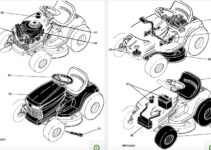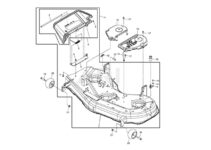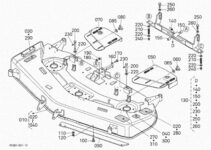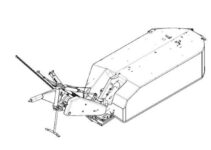Honda HRX217 is the perfect mower for people seeking reliable performance with a sleek minimalist design. This mower provides the ultimate mowing experience rare in most other lawnmowers.
Generally, the HRX series is the ultimate lawn mower that features self-propulsion and Honda’s exclusive Versamow system TM, allowing users to mulch, bag, or shred leaves partially.
In this guide, we’ll reveal the components of the Honda HRX217 through a diagram and explain the significant ones explicitly.
Let’s get started.
Honda HRX217 Parts Diagram
The entire line of Honda mowers features incredible technology, and the Honda HRX217 is no exception. The engine is easy to start, durable, and offers longevity. The lawnmower is built with just a few essential parts. However, none exist individually, as they all work together to function adequately.
Below is the diagram showing the different components of the Honda HRX217:
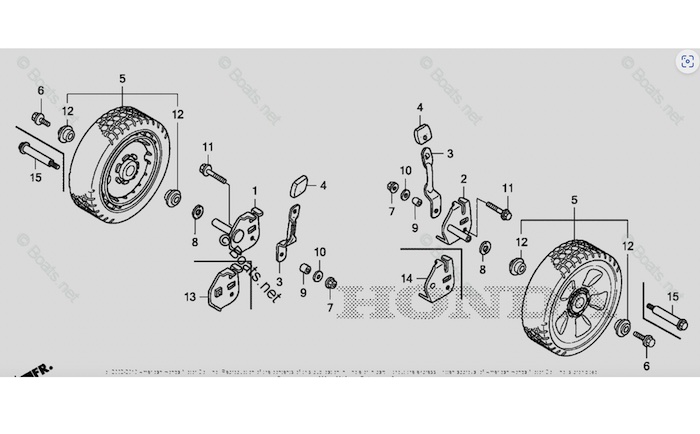
- Right Arm Adjuster
- Left Arm Adjuster
- Plate Adjuster
- Grip Adjuster
- Wheel
- Wheel Bolt
- Self-Lock Nut
- Wheel Washer
- Arm Collar
- Plain Washer
- Flange Bolt
- Bearing Wheel
Honda HRX217 Parts Explained
The Honda HRX series was introduced in 2004, and this line pioneered the unique Versamow System with Clip Director, the first of its kind. This feature allows users to enjoy simultaneous distribution of clippings in the ground and the bag.
The Honda HRX series was expanded in 2008 with the introduction of the premium HRX217. It uses the four-stroke, single-cylinder OHC engine. As the diagram depicts, it comprises some crucial parts. Understanding the function of these parts will enable you to run them in top condition.
Here’s the function of some crucial components of the Honda HRX217 lawn mower:
Lawn Mower Blade
As you likely imagine, the lawn mower blade serves as the lawn mower itself as it’s the cutting component of the mower. The blade is usually designed with string metals to tolerate speed contact with different parts during mowing operation.
There are two forms of lawn mower blades: the lawn mower disc and the lawn mower plate. However, both types are equally good and serve well while mowing. Generally, the blade’s design, size, materials, and thickness vary by manufacturer.
Flywheel
Flywheels play a crucial part in lawnmowers. A flywheel is a wheel that serves as a balancing device and the location where magnets are fastened. The flywheel on lawnmowers has a fan that acts as a coolant.
Cylinder Block
A lawn mower’s cylinder block acts as the engine’s point of combustion. There is a hole for the spark plugs inside the cylinder block. The lawn mower’s cylinder block is small, so if it is destroyed, it cannot be executed due to its small size.
Spark Plug
Your lawnmower’s spark plugs are the component that creates the electric spark needed to light up the fuel in the engine. They can be found on either gasoline- or diesel-powered engines.
A spark must ignite the fuel-air mixture in the combustion chamber. When the engine piston is nearly at the top of its stroke, an electrical current provides power to the plug to produce a spark. The spark causes the fuel system to “explode,” which forces the piston back down in the engine and turns the crankshaft.
Spark plugs typically last two years, but this can change depending on how frequently you use your lawnmower and how you take care of them. The spark plug’s lifespan will be shortened if it is not replaced when it should be.
Piston
The piston is made up of a piston rod and a piston ring. This series of components work as a compression in the machine. The cylinder block contains a piston, and the mechanism works in a back-and-forth motion as directed by the crankshafts.
Clutch
The lawn mower’s clutch is essential to its operation. It is where the engine and blade are connected, transferring power to cut grass. It is constructed of numerous intricate parts, including a strong magnet that engages the blade.
The brake pad, which is the component that slows the blade when you turn off your lawn mower, is also a part of it—your lawn mower’s clutch transfers engine power to the mower’s blades.
Flexible Shaft
A flexible shaft connects the lawn mower propeller to the main engine. The grass-turning handle can be deflectable in any direction with flexible shafts.
Air Filter
The air filter guards against dirt and debris getting into the engine’s internal workings. Dust, dirt, and other debris are eliminated from the air before it enters the mower’s machine by the air filter.
The engine may run better if it is clogged or dirty. Furthermore, the air cleaner prevents debris from entering the carburetor, enabling an unhindered flow of air and gasoline.
Although the lawn mower engine will still run without an air cleaner, it will take only a short time before dust, and other residues cause internal parts to malfunction.
